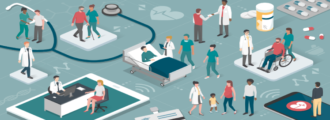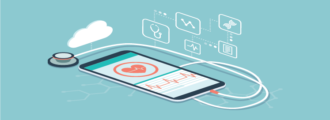Imagine a world where healthcare providers can seamlessly exchange and access patient data, regardless of disparate systems and technologies; a world where patients have real-time access to their comprehensive health information, empowering them to make better-informed decisions about their care…
This is the world that HL7 FHIR aims to create, revolutionizing healthcare data exchange and interoperability across the board. But how does it work, and what makes it so transformative?
Fast Healthcare Interoperability Resources (FHIR) is a healthcare data standard that enables the efficient exchange of patient information among healthcare providers, improving patient care and clinical decision-making.
In this blog post, we will explore the origins, benefits, and future potential of FHIR, as well as delve into its technological backbone, the power of its resources, and where our team of HL7 consultants can fit in your organization.
Short Summary
- HL7 FHIR is a free, open-source healthcare data standard designed to enable secure and efficient data exchange among healthcare organizations.
- Adopting the FHIR standard provides numerous advantages such as improved interoperability, streamlined data management, increased efficiency for developers and enhanced patient care.
- HL7 FHIR is paving the way for innovative solutions in healthcare that promise to revolutionize the patient experience.
Fast Healthcare Interoperability Resources with HL7 FHIR
HL7 FHIR is a healthcare data standard designed to facilitate seamless data exchange and interoperability among healthcare organizations. It allows for the secure storage, retrieval, updating, and sharing of patient data, eliminating the barriers that previously hindered efficient data exchange.
The ultimate goal of FHIR is to transform patient care and clinical decision-making by enabling healthcare providers to access critical information in a timely fashion, utilizing the FHIR data model.
How it all started…
The origin of FHIR lies in the vision of its creators, who recognized the limitations of previous HL7 versions and sought to develop a free, open-source data standard that would overcome these obstacles.
They envisioned FHIR as a fundamental set of resources, supported by a cohesive FHIR community, that would address the majority of common use cases in healthcare data exchange. They also built upon familiar web technologies such as XML, JSON, HTTP, OAuth, and REST, making it easy for developers to implement and integrate with existing systems.
This approach has led to the widespread adoption of FHIR, as evidenced by the ONC’s 21st Century Cures Act Final Rule, which requires EHR vendors to implement support for SMART on FHIR Core Capabilities.
The Power of FHIR Resources
FHIR resources are modular, reusable building blocks that address common clinical use cases, enabling targeted data requests and efficient information exchange across the entire organization.
With approximately 150 resources included in the FHIR specification, these components can be combined to accommodate a wide range of healthcare data requirements. This flexibility allows healthcare providers to access and share patient data more effectively, promoting interoperability and seamless data exchange.
FHIR enables granular data access to individual items within resources, supports all the technologies employed by mobile devices, utilizes RESTful API protocols familiar to developers, and promotes privacy.
FHIR resources also simplify data transformation into usable formats and facilitate atomic data access, meaning that only the most pertinent information is shared with requesters, rather than bulky XML records.
Resource Customization and Profiling
FHIR resources can be tailored and profiled to suit particular workflows and use cases, with extensions to include or limit data elements. This customization allows healthcare organizations to adapt FHIR resources to their specific needs, ensuring that the data exchanged is both relevant and accurate.
By customizing FHIR resources to fit their unique requirements, healthcare providers can ensure that their systems operate effectively and efficiently, maximizing the benefits of FHIR implementation.
Understanding FHIR’s Technological Backbone
FHIR leverages familiar web technologies such as XML, JSON, HTTP, OAuth, and REST, providing a solid technological backbone for its implementation. By utilizing these common technologies, FHIR simplifies the process of integration with existing systems and makes it easier for developers to work with the standard.
This technological foundation is built on a RESTful API for health data exchange, with resources as its core components. And, by employing well-known web technologies in its infrastructure, FHIR ensures that developers can easily understand and implement the standard, accelerating the adoption of FHIR across the healthcare industry.
Benefits of Adopting the FHIR Standard
Adopting the FHIR standard offers numerous benefits for healthcare organizations, including improved interoperability, patient-centric healthcare, streamlined data management, and increased efficiency for developers.
By facilitating the secure transmission of patient data and providing real-time access to essential health information, FHIR empowers patients to make better-informed decisions about their care.
FHIR also simplifies data transformation into usable formats and enables the standard exchange of healthcare data. And, the open APIs offered by FHIR facilitate uninterrupted real-time data transfer and provide developers with convenient access to healthcare data from healthcare applications.
Integrating FHIR with Legacy Health Systems
FHIR supports integration with legacy health systems, offering a flexible and adaptable solution for healthcare providers looking to transition towards modern data exchange standards.
This integration involves enabling interoperability between the systems by converting data between FHIR and the legacy system’s format, exposing individual resources, and standardizing data extraction and sharing using FHIR healthcare.
Despite the challenges associated with FHIR implementation, such as ensuring data security and privacy, guaranteeing data accuracy and timeliness, and investing in new technology, the benefits of FHIR far outweigh these obstacles.
By integrating FHIR with legacy health systems, healthcare providers can leverage the advantages of this innovative standard to improve patient care and streamline data management.
FHIR’s Role in Patient Data Access and Empowerment
FHIR plays a crucial role in patient data access and data sharing, empowering patients by providing secure, real-time access to electronic health records. This enables patients to gain a comprehensive view of their health information, allowing them to make informed decisions about their care and fostering improved patient engagement over time.
By granting patients straightforward and secure access to their comprehensive data, both in real-time and in the past, patients can gain an overall perspective of their health and make informed decisions regarding their care. This increased engagement in their healthcare journey ultimately leads to better health outcomes and more satisfied stakeholders in the long run.
The Impact of FHIR on Clinical Decision Support
FHIR enhances intelligent clinical decision support by facilitating the secure transmission of patient data and enabling real-time access to critical health information, including clinical documents.
By improving the alignment of healthcare data with clinical decision-making processes and allowing for the representation of clinical knowledge artifacts such as decision support rules and order sets, FHIR significantly impacts the effectiveness of clinical decision support.
FHIR also allows for the standard exchange of healthcare data, real-time data integration, and improved alignment with clinical decision-making processes, all of which contribute to data interoperability. This ultimately leads to better patient outcomes, as healthcare providers are able to access and use the information they need to make informed decisions about patient care through health information exchange.
Overcoming Challenges with FHIR Implementation
While implementing FHIR may present challenges such as data privacy concerns, competing priorities, and resistance to change, the benefits and potential for innovation offered by FHIR far outweigh these obstacles.
By addressing these challenges and focusing on the advantages of FHIR implementation, healthcare providers can harness the power of this innovative standard to improve patient care, streamline data management, and enhance chronic disease management.
To overcome these challenges, healthcare organizations must invest in new technology, ensure data security and privacy, and guarantee data accuracy and timeliness. By tackling these obstacles head-on and recognizing the value of FHIR as a powerful tool for healthcare data exchange, organizations can successfully implement FHIR and unlock its full potential.
And, for integration issues that go beyond the capabilities of new technology or built-in support services, bringing on an experienced HL7 consulting firm (like Surety Systems, hint hint) can help companies achieve even their most complex or difficult business objectives.
This way, organizations can proactively address minor issues and resolve them before they become major problems, making it easier to guarantee better productivity, efficiency, and engagement over time.
The Future of HL7 FHIR: Innovations and Possibilities
The future of HL7 FHIR holds exciting possibilities, including leveraging patient-generated health data, mobile app integration, and the development of a unified healthcare operating system. As FHIR continues to evolve and expand, the potential for innovation in the healthcare industry is limitless.
Imagine a future where patients can seamlessly access and manage their health data through mobile applications, healthcare providers can easily collaborate and share information, and a unified healthcare operating system streamlines the entire healthcare experience. This is the future that HL7 FHIR aims to create, and as it continues to develop and grow, the possibilities are endless.
How Can We Help?
Now you may be asking where HL7 consulting services (like the ones we offer at Surety Systems) can help improve the efficiency of your HL7 FHIR operations, drive communication and collaboration between teams, and help you make the most of your investments…
Well, our team achieves this by finding the ‘best-fit’ consultants for your project needs and keeping your needs at the top of the priority list, no matter what. And, with the skills and experience you need from a team of consultants, our HL7 consulting team is sure to knock any project out of the park.
We don’t work just to meet our own bottom line; we stay committed to your needs, ensuring that your projects are completed correctly, on time, and within budget. This way, you can rest assured knowing complex integration tasks are handled efficiently and effectively, without breaking the bank in the process.
Getting Started with Our Team
Interested in learning more about the HL7 FHIR standard and how it can transform your company’s data sharing capabilities? Ready to get started on a project with our team of expert HL7 consultants?
Contact us today to learn more!
Frequently Asked Questions
What is difference between HL7 and FHIR?
HL7 uses XML for communication, whereas FHIR uses RESTful web services and open web technologies such as XML, JSON, and RDF. This makes FHIR a more modern and flexible solution compared to HL7.
What is HL7 FHIR standard?
FHIR is an HL7 standard that defines how healthcare information can be exchanged between systems, advancing interoperability across the healthcare community. It enables the secure and reliable exchange of data regardless of how it is stored.
How does FHIR support integration with legacy health systems?
FHIR enables interoperability between legacy systems, facilitates data conversion, and standardizes data extraction and sharing, supporting integration with legacy health systems.
What is the role of FHIR in patient data access and empowerment?
FHIR facilitates secure, real-time access to patient health data, empowering them to make informed decisions and become actively engaged in their care.
By providing access to this data, patients can make more informed decisions about their health and become more actively involved in their care. This can lead to better outcomes and improved patient satisfaction.
What is the future potential of HL7 FHIR?
HL7 FHIR has a bright future, offering potential for utilizing patient-generated health data, integrating with mobile apps, and creating a unified healthcare operating system.
It has the potential to revolutionize the way healthcare is delivered, by providing a secure, interoperable platform for exchanging data between healthcare providers, patients, and other stakeholders. It could also enable the development of innovative applications and services that could improve patient outcomes.



